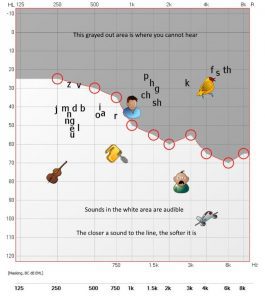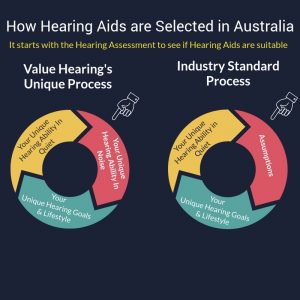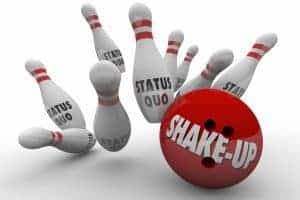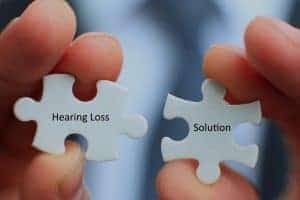Time to Read: 25 minutes
Reasons Why You Cannot Hear in Noise with Hearing Loss:
- The Shape of Your Hearing Loss
- How Well is Your Brain Able to Understand Speech in Noise?
- So Why Do Some People Do Well with Hearing Aids in Noise and Not Others?
- Some Theoretical Examples
- Why is the Industry Standard Still Based on Lifestyle Charts When Better Options Exist?
- How Do I Get Access to Product Matched Speech in Noise Testing?
- You Are Too Far From Me, How Can I Still Get This Information?
Difficulty hearing and understanding speech in noise is one of the early symptoms of hearing loss. It also tends to be one of the more annoying parts of hearing loss as it can cause quite a bit of frustration and embarrassment.
When I asked one client why she chose to see us for her first test. She said, “It’s because I had a very embarrassing moment this week.”
She went on to explain that she had met up with a group of friends, who she had not seen for a while. They chose a busy little cafe for the meet-up. As they were chatting, she was having quite a bit of difficulty hearing. One friend said something that she did not hear clearly. As a way of compensating, rather than asking her to repeat what was said, she simply replied: “That’s nice”. After the meeting, another friend called her aside and asked her why she had said, “That’s nice”, when she was just told that a friend’s mother had died. She made an appointment for a hearing test that same day.
On the lighter side of things, another gentleman once told me he ended up with a new hair colour when he attended the barber. He was unable to clearly hear the barber over the sound of the hair clippers. When the barber asked “something” he replied: “Sure”. Suddenly the barber proceeded to colour his hair to his utmost surprise!
Reasons Why You Cannot Hear speech clearly in Noise with Hearing Loss:
The Shape of Your Hearing Loss
The most common type of hearing loss is called sensorineural hearing loss, also called nerve deafness or permanent hearing loss, which affects little hair cells inside the inner ear. Initially, this affects our ability to pick up the soft parts of speech, most commonly in the high pitch range. This makes speech less clear even though the volume of speech, which is perceived in the low pitch range, might still be normal or at least better than the high pitch hearing.
Below is an example of a high-pitched hearing loss in the right ear. The greyed-out area is the area where the client cannot hear anything. The white area contains the levels and sounds that this client can hear. As you can see all the vowels are audible. They convey volume. The consonants are inaudible. They convey clarity. So this client may feel that speech is loud enough and he can cope, so long as the speaker looks at him whilst speaking, as he gets the missing sounds by “reading” their lips.
Do you ever feel you would hear better if only people just looked at you whilst speaking?
The problem with most background noise is that it tends to be dominant in the low pitches. This then drowns out the better part of your hearing making it very hard to understand speech in party noise, as lip reading may only give you about 40% understanding of the speech.
How Well is Your Brain Able to Understand Speech in Noise?
If this is the only reason why someone with hearing loss cannot hear in noise, then it should be an easy “fix” by simply boosting the sounds the person cannot hear.
If this was true, then everyone wearing even the most basic hearing instruments should do marvellously well with them as they boost soft sounds more than they do moderate or loud sounds. They can shape the sound to improve hearing in the areas where you need more help. If professionally fitted, hearing aids can also reduce loud sounds, so that they don’t cause even more hearing loss.
So Why Do Some People Do Well with Hearing Aids in Noise and Not Others?
The reason for this is that the ear is simply a microphone to the brain. The brain is where hearing, and in particular, understanding of speech actually takes place.
Hearing aids correct for the ear damage on the outside before sending the corrected sound into the ear. This sound needs to travel through the ‘microphone’ of the damaged ear, and then sent for interpretation by the brain.
Two potential factors could be at play here:
- The damage in the ear might cause distortion, so the brain does not receive a clear enough sound to be able to understand.
- The brain itself may have trouble separating speech from noise. So if the signal is not clean enough, the brain cannot make sense of the speech. This relates to a brain function called auditory processing.
One or even both factors could be present in any individual along with hearing loss.
Either way, each person's brain is different when it comes to understanding speech in background noise.
Some people simply need a “boost” - like a graphical equaliser - in the sound they miss in order to hear really well. Others need a hearing aid to clean up the signal before their brain is able to understand speech in noise. Other less fortunate people, simply cannot hear well in noise, no matter how much the hearing aid tries to clean up the noise. They might require extra help, through specialised accessories, to stand a chance of coping in noisy situations.
The way in which each person’s ability to hear and understand speech in noise differs can be easily measured. The problem is that this individual ability is often not always measured during standard testing.
Instead, it is just assumed that everyone has average difficulty hearing ability in noise. This leads to hearing aids being selected based on the assumption that you are 'average'.
You are offered a selection of hearing aids based on your lifestyle, activity level and age. Hearing aids are priced based on the features they have. More expensive hearing aids have lots of features but can also clean up the speech from noise better.
Without taking your individual hearing ability to hear speech in the presence of backgroung noise into account, the clinician can only base their prescription based on your lifestyle, age and activity levels. If you have a busier lifestyle, you will need to pay more for a suitable hearing aid. If you have a less active lifestyle, you might be offered a less expensive hearing aid.
Ironically, this industry-standard method of hearing aid selection leads only to average outcomes. So, it is no surprise that it has been reported that up to ⅓ of people who are fitted with hearing aids don’t use them over the long term. Other studies have shown that on average there is no difference between the performance of basic hearing aids over premium hearing aids.
I believe the reason for this is that the current hearing aid selection process assumes average hearing in noise. So average recommendations deliver average performance in noise. Are you simply average?
Some Theoretical Examples:
Let's look at a few scenarios with a few fictitious people with hearing loss, and compare the industry standard hearing aid selection process to an alternative: the individualised evidence-based selection process.
John:

Industry Standard Process - Assuming Average:
John has a very active lifestyle. He frequents restaurants, has an active social life and does infrequent consulting work. He attends a hearing test and mentions that his biggest trouble is hearing speech clearly in noise. He is diagnosed with moderate high-frequency hearing loss. Due to his active lifestyle, he is recommended the most expensive hearing aids as this is what the manufacturer’s lifestyle chart suggests. He is very happy with the hearing aids and recommends them to all his friends. He warns them, however, that hearing aids are very expensive, but it is worth it to go for the best you can afford.
Evidence-Based Process - Measuring His Unique Hearing Ability in Noise
John does very well in the speech in noise test once his hearing loss is taken out of the picture. In fact, his hearing ability in noise is almost normal once the hearing loss itself has been corrected. He is recommended basic hearing aids, costing ¼ of what the expensive hearing aids, recommended under the previous method, would have cost. He is very happy with the hearing aids and tells all his friends. He tells them that hearing aids cost a lot less than he expected.
Sue:
Industry Standard Process - Assuming Average: 
Sue is nowhere near as active as John. She stays mainly at home, likes watching TV, attends church and catches up with her family in a small group at home once a week. She is diagnosed with a similar hearing loss configuration to John. Due to her more limited lifestyle, she is recommended middle-of-the-range hearing aids. She is terribly unhappy with the hearing aids as she cannot hear her family when they get together; nor can she engage in the after-church discussions. The TV is not very clear when watching movies and she still needs to revert to subtitles.
The clinician counsels her that she needs to allow time to get used to them or pay more for a “better hearing aid”. She tries a better hearing aid, and does a little better, but is still not quite happy. In order to not disappoint the clinician who has worked so hard to try to help her, she keeps the hearing aids, hoping things will improve in due course. Over time she wears the hearing aids less and less until she eventually gives up on them completely. She tells anyone willing to listen that hearing aids do not work.
Evidence-Based Process - Measuring Her Unique Hearing Ability in Noise
Sue is found to have severe difficulty hearing in noise when tested after the contribution of her hearing loss has been accounted for. She is recommended a pair of top-end hearing aids but is also advised that she might need an FM system to help her hear her family when they get together. Sue understands what to realistically expect and is delighted when the recommended solution improves her hearing significantly within the limitations that the clinician discussed with her. She continues using her hearing aids for years to come and recommends her friends also have their hearing checked.
Mary:
Industry Standard Process - Assuming Average:
 Mary is tested and found to have a hearing loss quite similar to that of Sue and John. She has a similar lifestyle to Sue and is recommended a similar level of hearing aid to what Sue was offered initially. She is reasonably happy and continues wearing the aids. She is a little disappointed that they do not work as well as she hoped in noise, but overall they seem okay.
Mary is tested and found to have a hearing loss quite similar to that of Sue and John. She has a similar lifestyle to Sue and is recommended a similar level of hearing aid to what Sue was offered initially. She is reasonably happy and continues wearing the aids. She is a little disappointed that they do not work as well as she hoped in noise, but overall they seem okay.
Evidence-Based Process - Measuring His Unique Hearing Ability in Noise
Mary is found to have moderate difficulty hearing in noise once the influence of her hearing loss has been taken into account. She is recommended a hearing aid that is a little bit more capable of improving speech in noise than what she would have been recommended just based on her lifestyle. She is delighted with its performance in most situations. Her confidence in her hearing improves drastically and she joins a social group as she can now partake in noisier conversations than before. She is happy to recommend hearing aids to anyone.
Why is the Industry Standard Still Based on Lifestyle Charts When Better Options Exist?
Clinical Processes are Slow to Change
Clinicians are often trained as scientists. As such, they tend to be wary of change and can be guilty of thinking: “if it isn’t broken, then why fix it?”. New assessment techniques and equipment typically take a decade or two before it becomes standard throughout the medical industry. The Industry Standard Hearing Aid Selection method is well entrenched in everyday clinical work, so it is a tough nut to crack.
Clinic Profitability
The unfortunate truth is that there is generally relatively higher profit to be made off top-end hearing aids in retail (and wholesale) than there is from more basic hearing aids. Similarly, some clinics pay commissions or profit shares to clinicians, which drives the sales of more profitable hearing solutions over less profitable models. As such, speech in noise testing is not often part of the clinical process as it can, and regularly does, suggest a more basic hearing aid is required than suggested by the lifestyle chart. If it is available, there tends to be no way to link an individual’s performance on the test to a specific model or level of hearing aid.
Some clinics are now moving away from commission-based schemes, but without the correct processes being enforced, the client outcomes remain unchanged.
Lack of Available Tools
Speech in noise testing is readily available. Unfortunately, not all testing equipment easily supports it. Even if the equipment was capable of performing speech in noise testing, the required module to be able to do the test is missing from many clinics’ equipment. So if the clinician does not have easy access to this sort of test, it is a big ask for them to bring a process, not supported by their employer, into their already busy schedule.
Update: I have recently seen more hearing test results which also include speech in noise test results. Despite these results being present, they seem to have little impact on how hearing aids are being recommended.
On a more negative note, I have even heard that some clinics use these speech-in-noise tests to convince clients that their hearing is worse than they thought. The clinics do this by using these test in ways they were not intended. Essentially the test is performed at very soft levels, where you have no option but to fail. They then redo the test with hearing aids and suddenly you do better. Speech in noise testing generally needs to be presented at loud but comfortable levels, not at barely audible levels.
Manufacturers Support the Standard Method
The way manufacturers promote hearing aids and separate them into different levels is consistent with the lifestyle way of hearing aid selection. To compound this, there are many features in top-end hearing aids, that “sound” like good features, but have little evidence to support their efficacy. So clinicians and hearing aid users alike are easily misled by a lot of marketing claims. We have an article here to highlight the most important hearing aid features.
There is no easily obtainable way to assign a specific hearing aid performance to a specific speech in noise score based on the information provided to the clinician. Unfortunately for the manufacturer, the profit margins are also larger on more premium products.
How Do I Get Access to Product Matched Speech in Noise Testing?
Value Hearing had to develop our own method over time, combined with careful study of any information available about a specific hearing aid, to find our unique matching criteria. We adjust the criteria, as real-life usage data is collected, to ensure outcomes are realistic and consistent. We have been refining and improving this process since 2009.
Our clinicians have access to these figures via a unique in-house developed system. It captures your unique speech in noise perform ance score and calculates the amount of brain support any given hearing aid will provide you in real-time. If the needle is in the green area, the clinician can be confident that the level of support provided by a specific solution is in the ideal range. If the needle is too far to the left, the amount of support is insufficient and you are likely to experience challenges in difficult situations. If the needle is too far to the right, then you are likely to be over-prescribed. We then also take lifestyle, age and activity level into account.
ance score and calculates the amount of brain support any given hearing aid will provide you in real-time. If the needle is in the green area, the clinician can be confident that the level of support provided by a specific solution is in the ideal range. If the needle is too far to the left, the amount of support is insufficient and you are likely to experience challenges in difficult situations. If the needle is too far to the right, then you are likely to be over-prescribed. We then also take lifestyle, age and activity level into account.
Note: We are starting to see some early data filtering through that suggests that over-prescription may cause the brain to become lazy. (More data is needed to confirm this). So simply getting the best you can afford may not be the best way to go.
We are hoping to launch this unique and effective selection to the rest of the industry in 2023 so that more clients can benefit from this ethical and effective approach.
Using this method, we have achieved long-term hearing aid usage rates that appear significantly better than the industry standard.
The benefits of this evidence-based method to you are:
- You never pay more than you absolutely need to in order to get the optimal benefit;
- You are unlikely to be recommended a hearing aid that will not perform as intended;
- You require less back and forth and research time in order to end up with your best option;
- You can be confident in your choice as we guarantee your success;
- You will know beforehand if your hearing in noise requirements is beyond what technology can offer. We can then help you in other ways. This avoids disappointment and rejection of hearing solutions;
- You are much less likely to give up on your hearing solution due to a lack of performance.
- Your brain receives just the right amount of stimulation in needs to challenge and support it.
Our clinicians also benefit:
- They can be much more confident in the recommendations they make to you;
- They can work ethically, prescribing what you need without overprescribing;
- They get to work with happier clients, who have realistic expectations around their hearing aids;
- They never have to worry about commissions when making recommendations, they simply use the available facts;
- They are much more likely to recommend a solution that will keep their client satisfied for years to come.
To obtain your recommendation using our unique process, book your appointment here.
Note: Speech in noise testing can only be conducted on clients with a good handle on English, as English speech material is used.
You Are Too Far From us, How Can I Still Get This Information?
We would love to help where we can. We have developed an online assessment that gives you a reasonably accurate test from the comfort of your own home:





